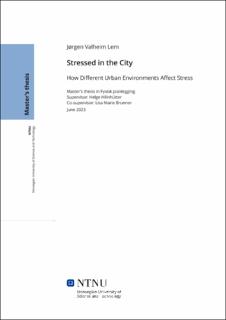| dc.description.abstract | This master's thesis presents a study that utilizes biosensors to assess heart rate variability (HRV) and stress levels among participants in various urban environments. The goal of the study is to investigate the relationship between different urban environments and physiological and psychological responses and view such data in conjuncture with participant self-reports. The study adopts a mixed-methods approach combining physiological measurements with subjective feedback to gain a comprehensive understanding of the relationship between urban environments, HRV, and perceived stress.
The research employs a wearable biosensor to collect real-time HRV data from participants while they navigate distinct urban contexts. These environments include parks, industrial estates, and residential areas. The biosensor data captures HRV parameters such as time-domain and frequency domain.
Furthermore, participant self-reports are collected partly through structured questionnaires and partly through a semi-structured interview, capturing subjective affect and perceptions of the built environment. By comparing objective physiological data with self-reported data, a comprehensive assessment of stress and its relation to urban environments is achieved.
Findings from this thesis indicates that there is a correlation between objective physiological data and subjective self-reports. Participant-expressed dissatisfaction with urban qualities overlapped to a quite large degree with areas of heightened indicated stress levels. The built elements which were negatively perceived, included areas largely designed for car accessibility, areas with industrial architecture, and a pedestrian underpass which was particularly dim-lit and claustrophobic.
Keywords: Heart rate variability, stress, biosensors, urban environments, self-reports, physiological measurements, walkability. | |
